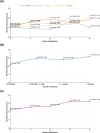Analysis of risk factors associated with meibomian gland orifice obstruction severity in glaucoma patients: a clinical investigation
- PMID: 41073935
- PMCID: PMC12512833
- DOI: 10.1186/s12886-025-04378-0
Analysis of risk factors associated with meibomian gland orifice obstruction severity in glaucoma patients: a clinical investigation
Abstract
Purpose: To investigate the synergistic effects of duration of glaucoma and number of medications on meibomian gland orifice obstruction severity in glaucoma patients, aiming to optimize therapeutic strategies for ocular surface protection.
Methods: This retrospective study analyzed 120 glaucoma patients with concurrent MGD. Meibomian gland orifice obstruction was scored using standardized criteria. The relationship between obstruction scores and clinical factors was evaluated using Spearman correlation and generalized linear modeling.
Results: Significant correlations were found between MG orifice obstruction score and duration of glaucoma (r = 0.309, P < 0.001), number of medications (r = 0.340, P < 0.001), number of preserved eye drop products (r = 0.300, P < 0.001) and duration of medication (r = 0.398, P < 0.001). Generalized linear modeling revealed significant main effects of duration of glaucoma and number of medications (P = 0.012 and P = 0.005), with a significant interaction (P = 0.020). After 3 years of glaucoma, any medication regimen significantly increased obstruction scores compared to no treatment (all P < 0.05). Triple or quadruple therapy showed significantly higher obstruction scores versus no medication (P = 0.002 and P = 0.008).
Conclusion: Duration of glaucoma and number of medications synergistically worsen MG orifice obstruction, with a critical threshold after one year of disease. These findings suggest the importance of reducing medication burden in long-term glaucoma patients.
Keywords: Duration of glaucoma; Glaucoma; Meibomian gland dysfunction; Number of medications; Orifice obstruction.
© 2025. The Author(s).
Conflict of interest statement
Declarations. Ethics approval and consent to participate: The study protocol adhered to the tenets of the Declaration of Helsinki and received approval from the Ethics Committee of the Eye & ENT Hospital of Fudan University. The requirement for informed consent was waived due to the retrospective nature of the study. Competing interests: The authors declare no competing interests.
Figures



References
-
- Chinese Branch of the Asian Dry Eye Society; Ocular Surface and Tear Film Diseases Group of Ophthalmology Committee of Cross–Straits Medicine Exchange Association; Ocular Surface and Dry Eye Group of Chinese Ophthalmologist Association. Chinese expert consensus on meibomian gland dysfunction: definition and classification (2023). Zhonghua Yan Ke Za Zhi. 2023;59(4):880–7. 10.3760/cma.j.cn112142-20230114-00023. - PubMed
-
- Lin PY, Tsai SY, Cheng CY, Liu JH, Chou P, Hsu WM. Prevalence of dry eye among an elderly Chinese population in Taiwan. Ophthalmology. 2003;110(6):1096–101. 10.1016/S0161-6420(03)00262-8. - PubMed
-
- Jie Y, Xu L, Wu YY, Jonas JB. Prevalence of dry eye among adult Chinese in the Beijing eye study. Eye. 2009;23(3):688–93. 10.1038/sj.eye.6703101. - PubMed
-
- Kojima T, Dogru M, Matsumoto Y, Goto E, Tsubota K. Tear film and ocular surface abnormalities after eyelid tattooing. Ophthalmic Plast Reconstr Surg. 2005;21(1):69–71. 10.1097/01.IOP.0000153028.08506.47. - PubMed
MeSH terms
Substances
Grants and funding
LinkOut - more resources
Full Text Sources
Medical

